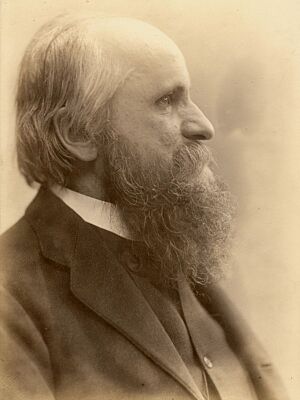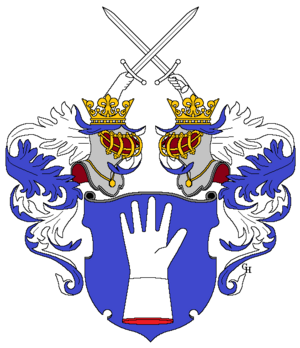Alexius Meinong facts for kids
Quick facts for kids
Alexius Meinong
|
|
|---|---|

Meinong, c. 1900
|
|
| Born |
Alexius Meinong Ritter von Handschuchsheim
17 July 1853 |
| Died | 27 November 1920 (aged 67) |
| Education | University of Vienna (PhD, 1874) |
| Era | 20th-century philosophy |
| Region | Western philosophy |
| School |
|
| Institutions |
|
| Academic advisors | Franz Brentano |
|
Main interests
|
Ontology, theory of objects, philosophy of language, philosophy of mind, value theory |
|
Notable ideas
|
Theory of objects, nonexistent objects, Meinong's jungle, nuclear vs. extranuclear (constitutive vs. extra-constitutive) properties (konstitutorische vs. außerkonstitutorische Bestimmungen) of objects, the existence–subsistence–absistence distinction, wide and narrow negation |
Alexius Meinong Ritter von Handschuchsheim (born July 17, 1853 – died November 27, 1920) was an Austrian philosopher. He was known for his special ideas about "objects" and what it means for things to "be" or "not be." He also studied how our minds work and how we decide what is valuable.
Life
Alexius Meinong's father, Anton von Meinong, was an army officer. He became a Major General before he retired. In 1851, his family was given the special title of Ritter.
From 1868 to 1870, Meinong went to school in Vienna. In 1870, he started studying law at the University of Vienna. He became very interested in economics. In 1874, he earned a doctorate degree in history.
Later, Meinong began to focus on history and philosophy. He became a student of Franz Brentano, a philosophy professor. Meinong said Brentano helped him a lot in his philosophy studies. He also studied with Edmund Husserl, who became another famous philosopher. Both Meinong and Husserl developed similar ideas in their work.
In 1882, Meinong became a professor at the University of Graz. He later became the head of the philosophy department there. He started the Graz Psychological Institute in 1894. This institute was important for studying experimental psychology. Meinong also taught other students who became famous, like Christian von Ehrenfels, who started Gestalt psychology.
Work
Theory of Objects
Meinong is most famous for his book Theory of Objects (1904). This book explored his ideas about how we think about things. He believed that anything we can think about is an "object."
His "theory of objects" explores how we can think about things that don't actually exist. For example, you can imagine a golden mountain, even though it's not real. Meinong said that because we can refer to such things, they must have some kind of "being."
He explained that an object can be a "target of thought" even if it doesn't "exist" in the real world. He called these non-existent objects "homeless." Other philosophers sometimes jokingly called the place where these objects "live" "Meinong's jungle" because there are so many strange and imaginary things there.
Some people, like Bertrand Russell, questioned Meinong's ideas. However, Russell also respected much of Meinong's work. More recently, other philosophers have shown that Meinong's theory of objects makes sense.
Meinong also had interesting ideas about the word "existence." He thought that "existence" was not just a simple property of an object, like its color or size. Instead, he believed that objects are "indifferent to being." This means an object's true nature depends on its properties, whether it exists or not. For example, a unicorn still has the property of being a horse with a horn, even if it doesn't exist.
Different Kinds of Objects
Meinong thought that objects could be grouped into three types based on how they "are":
- Existence (Existenz): This means an object is real and exists in time and space. Examples are mountains or birds.
- Subsistence (Bestand): This means an object "is" but not in a real, physical way. It doesn't exist in time. Examples are numbers or math rules. These objects just "are" in a non-physical sense.
- Absistence or being-given (Gegebenheit): This means an object is simply something we can think about. It doesn't have to exist or subsist. For example, an impossible object like a "square circle" cannot exist or subsist, but we can still think about it. Meinong said that everything we can think about "absists."
Objects and Our Minds
Meinong also connected different types of "objects" to different ways our minds work:
- Objects (Objekt): These are things, whether real (like horses) or ideas (like the idea of "difference"). Our minds represent or imagine these.
- Objectives (Objectiv): These are like facts or ideas that can be true or false. For example, "the sky is blue." Our minds think about these.
- Dignitatives: These are things we value, like what is true, good, or beautiful. Our minds have feelings about these.
- Desideratives: These are things we want or feel we should do, like duties or goals. Our minds have desires for these.
See also
 In Spanish: Alexius Meinong para niños
In Spanish: Alexius Meinong para niños
- Modal Meinongianism
- On the Content and Object of Presentations by Kazimierz Twardowski


